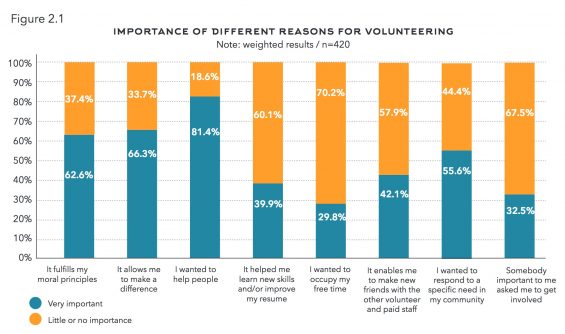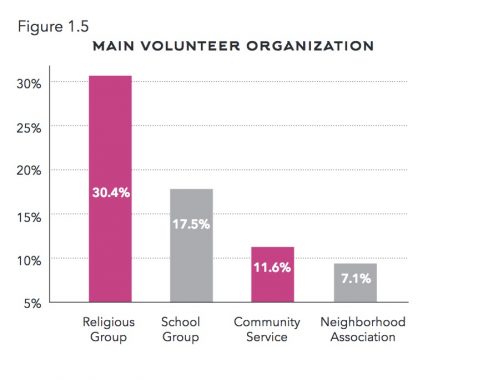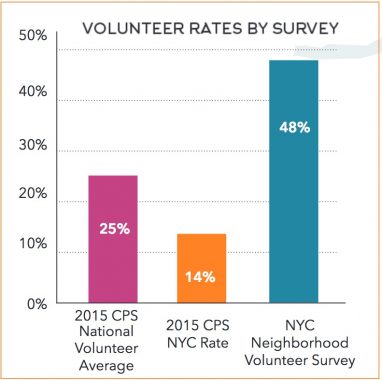
Findings from the NYC Services study
Aug. 8, 2017 By Nathaly Pesantez
Sunnyside, Woodside, and Jackson Heights are the focus of a new study released by NYC Service, where the three neighborhoods were shown to have a volunteer rate of 48 percent, according to a new door-to-door study on volunteerism by the city.
The study by NYC Service, a city organization that promotes volunteerism, and the CUNY Graduate Center, put a spotlight on the western Queens neighborhoods in an attempt to better grasp volunteering in the city as a whole.
Among the survey’s findings are that the demographic groups of the area traditionally associated at large with low volunteerism rates, like immigrant groups, lower income groups, and city residents, are actually volunteering at higher rates than thought.
Slightly over 33 percent of participants making under $20,000 a year volunteered, while 45.7 percent of participants making between $20,000 to $40,000 a year reported volunteering.
Among the native born/Puerto Rican participants, 53.9 percent reported that they volunteer, with the percent for non-citizens at 47.5 percent.
Furthermore, volunteering for religious organizations was the most popular method reported by the study group, with 30.4 percent of participants volunteering through them, followed by 17.5 percent volunteering through a school group.

NYC Services study
Participants for the western Queens survey also revealed that they were most likely to volunteer if it fulfilled their moral principles, with 62.6 percent marking it as “very important”, or if it allowed them to respond to a specific need in their community, with 55.6 percent of participants labeling this reason as “very important”.
NYC Service handed out surveys to participants chosen at random from the city’s database of residential buildings within the three neighborhoods, and asked questions on demographics, along with questions like why or why not they volunteer, and the different ways they volunteered, to better understand city volunteer rates as a whole. Over 850 responses were received.
The study, conducted between August 2016 and March 2017, reflect volunteering rates within Western Queens neighborhoods that are more than double the national figure as calculated by the U.S. Census Bureau in their Current Population Survey (CPS), according to NYC Services.

Volunteer rates by survey/NYC Service
The organization says the sizeable gap in Census Bureau results to that of the city are due to differences in the questions asked in the surveys, as the national survey does not explicitly ask participants about volunteering within their houses of worship—a category found to be widely popular among the study group.
“[T]raditional ways of defining and talking about volunteerism—formal opportunities on behalf of an organization—often do not fit the lives of many residents,” part of the study reads.
The study also reasoned that participants had a broader understanding of what it means to volunteer, with some answers including unpaid babysitting, sitting with an elderly neighbor, and activities like protesting and voting, all of which are not entirely connected to specific organizations, as most national surveys ask.
Along with the findings, NYC Service also found three factors that pose significant hurdles to volunteering –lack of time, lack of knowledge, and lack of access.
Given the findings of the survey, NYC Service also announced a new plan to make volunteering and civic engagement opportunities more visible, with test runs in neighborhoods across the city that once again will include Sunnyside, Woodside, and Jackson Heights.
“We know that strong, diverse, and vibrant communities have solid civic engagement at their core,” said Mayor Bill de Blasio in a statement. “This report tells us that New Yorkers are engaging in volunteerism at high levels, but it also tells us that as we work to inspire community engagement throughout the City, we must reach people in their neighborhoods to get more New Yorkers active and connecting to one another.
For access to the report, click here.
17 Comments

This report is 100% wrong. I have been volunteering in Woodside for 6 years. I cover graffiti, paint fire alarms and clean up garbage . In the past 6 years I have only been able to recruit three teenagers to help out. Everyone is too busy to clean their own neighborhood. Everyone expects the city to do Everything for them. I work 40 plus hours a week then I do an additional 20 hours of volunteer work and I Never run out of things to do.
If this report were true then there wouldn’t be a need for someone like me because the work would already be done.
I VOLUNTEER TO MOVE AWAY, FAR FAR WAAY.
Kareem how old you b ? Damn b, u never ain’t worked? How I got wit dat? Lemmeno!
Why are these obvious racist letters being published. Kelvin Jackson and Kareem obviously do not exist! My letters may be stupid but they are not racist.
Chilly no like fascists.
O.b.h- you can wash my car loser.
What’s that dumb name mean anyway
What are some good volunteer opportunities in Sunnyside? I’d like to volunteer
you can come clean my house, do my laundry. How about that?
I do el loco laundry
Why? Why the welfare peoples gotta work cleaning things? I collect welfare and I’m the 6th generation of my family to do so. Its the family business. My great-great-great-granddaddies could collect and not do anything for the money. My granddaddy and daddy never had to work. Why I gotta work? Shut up Mr anonymous. Go away.
Let all the welfare recipients volunteer. Clean the streets or something
Volunteer? EFF you!!!
“NYC Service also found three factors that pose significant hurdles to volunteering –lack of time, lack of knowledge, and lack of access.”
kinda hard to volunteer free labor when most companies expect you to work a minimum of 10 hours a day, put in overtime for free, just so you can pay your mortgage/rent and feed/take care of your family.
Stop whining.
Who cares
Volunteering is a waste of time and you don’t get paid for it.
How much did you get paid for this post?